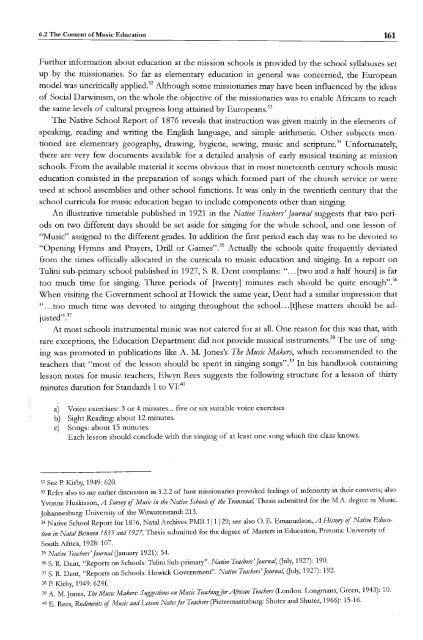South African Choral Music (Amakwaya): Song, Contest and the ...
South African Choral Music (Amakwaya): Song, Contest and the ...
South African Choral Music (Amakwaya): Song, Contest and the ...
Create successful ePaper yourself
Turn your PDF publications into a flip-book with our unique Google optimized e-Paper software.
6.2 The Content of<strong>Music</strong> Education 161<br />
Fur<strong>the</strong>r information about education at <strong>the</strong> mission schools is provided by <strong>the</strong> school syllabuses set<br />
up by <strong>the</strong> missionaries. So far as elementary education in general was concerned, <strong>the</strong> European<br />
model was uncritically applied. 32 Although some missionaries may have been influenced by <strong>the</strong> ideas<br />
of Social Darwinism, on <strong>the</strong> whole <strong>the</strong> objective of <strong>the</strong> missionaries was to enable <strong>African</strong>s to reach<br />
<strong>the</strong> same levels of cultural progress long attained by Europeans. 33<br />
The Native School Report of 1876 reveals that instruction was given mainly in <strong>the</strong> elements of<br />
speaking, reading <strong>and</strong> writing <strong>the</strong> English language, <strong>and</strong> simple arithmetic. O<strong>the</strong>r subjects mentioned<br />
are elementary geography, drawing, hygiene, sewing, music <strong>and</strong> scripture. 34 Unfortunately,<br />
<strong>the</strong>re are very few documents available for a detailed analysis of early musical training at mission<br />
schools. From <strong>the</strong> available material it seems obvious that in most nineteenth century schools music<br />
education consisted in <strong>the</strong> preparation of songs which formed part of <strong>the</strong> church service or were<br />
used at school assemblies <strong>and</strong> o<strong>the</strong>r school functions. It was only in <strong>the</strong> twentieth century that <strong>the</strong><br />
school curricula for music education began to include components o<strong>the</strong>r than singing.<br />
An illustrative timetable published in 1921 in <strong>the</strong> Native Teachers' Journal suggests that two periods<br />
on two different days should be set aside for singing for <strong>the</strong> whole school, <strong>and</strong> one lesson of<br />
"<strong>Music</strong>" assigned to <strong>the</strong> different grades. In addition <strong>the</strong> first period each day was to be devoted to<br />
"Opening Hymns <strong>and</strong> Prayers, Drill or Games".35 Actually <strong>the</strong> schools quite frequently deviated<br />
from <strong>the</strong> times officially allocated in <strong>the</strong> curricula to music education <strong>and</strong> singing. In a report on<br />
Tulini sub-primary school published in 1927, S. R. Dent complains: " ... [two <strong>and</strong> a half hours] is far<br />
too much time for singing. Three periods of [twenty] minutes each should be quite enough".36<br />
When visiting <strong>the</strong> Government school at Howick <strong>the</strong> same year, Dent had a similar impression that<br />
" ...too much time was devoted to singing throughout <strong>the</strong> schooL .. [t]hese matters should be ad-<br />
. d" 37<br />
Juste .<br />
At most schools instrumental music was not catered for at all. One reason for this was that, with<br />
rare exceptions, <strong>the</strong> Education Department did not provide musical instruments. 38 The use of singing<br />
was promoted in publications like A. M. Jones's The <strong>Music</strong> Makers, which recommended to <strong>the</strong><br />
teachers that "most of <strong>the</strong> lesson should be spent in singing songs".39 In his h<strong>and</strong>book containing<br />
lesson notes for music teachers, Elwyn Rees suggests <strong>the</strong> following structure for a lesson of thirty<br />
minutes duration for St<strong>and</strong>ards I to VI: 40<br />
a) Voice exercises: 3 or 4 minutes... five or six suitable voice exercises<br />
b) Sight Reading: about 12 minutes.<br />
c) <strong>Song</strong>s: about 15 minutes.<br />
Each lesson should conclude with <strong>the</strong> singing of at least one song which <strong>the</strong> class knows.<br />
32 See P. wby, 1949: 620.<br />
33 Refer also to my earlier discussion in 3.2.2 of how missionaries provoked feelings of inferiority in <strong>the</strong>ir converts; also<br />
Yvonne Husk1sson, A Survey of <strong>Music</strong> in <strong>the</strong> Native Schools of <strong>the</strong> Transvaal, Thesis submitted for <strong>the</strong> M.A. degree in <strong>Music</strong>.<br />
Johannesburg: University of <strong>the</strong> Witwatersr<strong>and</strong>: 213.<br />
34 Native School Report for 1876, Natal Archives PMB 111129; see also 0. E. Emanuelson, A History of Native Education<br />
in Natal Between 1835 <strong>and</strong> 1927, Thesis submitted for <strong>the</strong> degree of Masters in Education, Pretoria: University of<br />
<strong>South</strong> Africa, 1928: 107.<br />
35 Native Teachers' Journal Oanuary 1921): 54.<br />
36 S. R. Dent, "Reports on Schools: Tulini Sub-primary". Native Teachers' Journal, Ouly, 1927): 190.<br />
37 S. R. Dent, "Reports on Schools: Howick Government". Native Teachers' Journal, Ouly, 1927): 192.<br />
38 P. Kirby, 1949: 624f.<br />
39 A. M. Jones, The <strong>Music</strong> Makers: Suggestions on <strong>Music</strong> Teachingftr <strong>African</strong> Teachers (London: Longmans, Green, 1943): 10.<br />
40 E. Rees, Rudiments of <strong>Music</strong> <strong>and</strong> Lesson Notesftr Teachers (pietermaritzburg: Shuter <strong>and</strong> Shuter, 1966): 15-16.

















